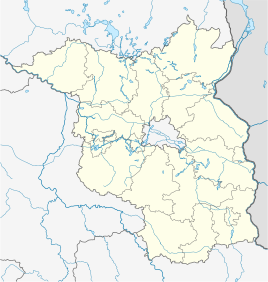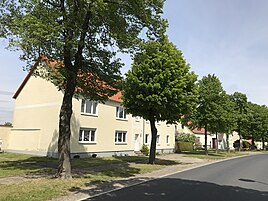Lichterfelde (Lower Fläming)
|
Lichterfelde
Niederer Fläming municipality
Coordinates: 51 ° 56 ′ 1 ″ N , 13 ° 12 ′ 27 ″ E
|
||
|---|---|---|
| Height : | 99 m above sea level NHN | |
| Residents : | 66 (December 31, 2018) | |
| Incorporation : | January 11, 1962 | |
| Incorporated into: | Advertising | |
| Postal code : | 14913 | |
| Area code : | 033746 | |
|
Location of Lichterfelde in Brandenburg |
||
|
Village street in Lichterfelde
|
||
Lichterfelde is a district of the municipality of Niederer Fläming in the south of the Teltow-Fläming district in the state of Brandenburg . Lichterfelde is a typical Brandenburg street village and consists of a village street on which almost all of the town's houses are located. These are predominantly four-sided courtyards or their remains, as the outbuildings have been demolished over time and there is no longer a closed courtyard structure. The village pond, which is located in the eastern part of the village opposite a small meadow, is characteristic of the place. On top of it is a small memorial stone erected in the mid-1990s for the victims of the Second World War.
history
The village of Lichterfelde was founded by Flemish settlers as part of the medieval German eastern settlement . This is reflected in the place name, which can be traced back to the West Flanders Lichtervelde . In the first written mention of the place from the year 1279 Lichterfelde is one of Gunther von Schwalenberg the Kloster Zinna left. The monastery sold the place to the Jüterbog office as early as 1463 and Lichterfelde was then an office village.
Up until the Peace of Westphalia, Lichterfelde was part of the ore monastery of Magdeburg , but then, like the entire area around Jüterbog, became part of Electoral Saxony and finally Prussian with the Congress of Vienna in 1815 . In 1962, Lichterfelde became part of the municipality of Werbig, since 1997 the village has been part of the municipality of Niederer Fläming, the administrative seat of which is in the village. At the end of 2011, Lichterfelde had 70 residents.
Attractions
- The village church of Lichterfelde from the first half of the 13th century is the oldest church in the Schlenzer parish. Until 1463 the church was the mother church, since then the daughter church of Sernow, whereby a parsonage was still available until 1562 in addition to the two Pfarrhufen. The oldest part of the church was built in the late Romanesque style and shows a typical structure of nave , choir and apse . In 1679 at the latest, when the western gable and tower wall was renewed in brick and the wooden roof tower was probably put on, the original apse was also demolished. The arched windows with brick frames and radial bars were installed in the 19th century, but two original slit-like windows, which are framed in granite, are still preserved on both sides of the nave. Inside the church, a round-arched triumphal arch has been preserved, which has been worked off on one side and is probably due to the previous pulpit. The interior of the church is rather sparse. The gallery, the stalls and the pulpit wall behind the altar from the first half of the 19th century are classicistic . The pulpit is located behind the altar, which is typical of this style, in contrast to the baroque pulpit altar, which is located above the altar. This element goes back to Schinkel , who is also reminiscent of the palm wreath on the sound cover of the pulpit. In 2009 the support association “Sanierung Lichterfelder Dorfkirche” was founded, which has set itself the goal of renovating and maintaining the church, as the church is in a poor structural condition.
- At the western entrance to the village there is a two-story half-timbered stable built in 1825 with a protruding upper arbor, which partially leads around the at right-angled gatehouse. The property is used today as a cultural center. Numerous events take place there, such as B. concerts, readings, lectures and film screenings in the small cinema.
- In addition to the church and the stable building, there is a homestead at Dorfstrasse 14, consisting of a residential building with an extension, a gatehouse, three stable buildings, a barn and a pigeon house, which are listed as historical monuments.
literature
- Christa and Johannes Jankowiak: Im Fläming , p. 152 FA Brockhaus Verlag Leipzig, 1988
- Carl Christian Hefter: Documented chronicle of the old district town of Jüterbog and its surroundings , Jüterbog 1851
Web links
Individual evidence
- ↑ Official Journal Dahme / Mark 3/2019
- ↑ Article Märkische Allgemeine from February 16, 2011: Lots of wood for the small village church . Website of the Verein Förderkreis Alte Kirchen Berlin-Brandenburg eV. Accessed on August 13, 2011.


